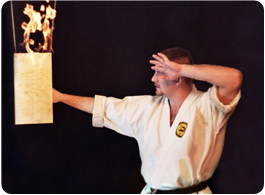LETTER 2. – Kata & bunkai
I certainly did not mean in my post to give the indication that all Okinawan schools did not continue to practice bunkai as an integral part of their training. I wrote that there are schools in Okinawa just as any other place in the world that do not have the full curriculum that other schools have. I certainly would not mention those that I think do or don’t. I know Iha sensei’s background as well as his teachers are and were well grounded on bunkai of the kata.
My comment was one of a general nature only depicting that there are bogus people all over the world. No one country or race has a monopoly on ignorance or charlatism. It just appears that the USA has more than our fair share.
Concerning the Japanese not understanding the bunkai from the Okinawans. I think I can fairly state that bunkai from the Okinawans perception was not part of their curriculum. They took the parts of the Okinawan karate that they wanted for their purposes and developed that part to a high degree. You cannot deny that the gymnastic, athletic movements of the Japanese styles is not better developed than the Okinawans.
Someone mentioned in a post yesterday that the way the Japanese had changed karate or taken the Okinawans “school” karate and spread it world wide and would we rather have karate spread out for everyone to enjoy or have kept it like the Okinawans developed it. My response is that I would rather have the “school” karate spread through out the world if that is what it takes to build the karate-do spirit and body for so many people to have gotten benefit from. Perhaps Itosu sensei knew that the real Okinawan karate was just for the few and school karate was for the populace. I am teaching school karate to the all of the young people that come into my schools with hopes that they will develop the body they need to grow to an adult and then began learning karate. I hopefully will retire from my business career in a couple of more years and then I would like to teach in the middle and high schools along with the colleges in my area. I have been thinking for sometime what I would teach given the opportunity to teach hundreds of people in that environment. I keep coming up with the same concept that Itosu used.
Modern karate as developed by the Japanese with a kick start from Itosu and Funakoshi is for the masses and there has been and continues to be a great benefit from this training. The traditional Okinawan karate is not for the masses and it was never intended to be that way.
I had the opportunity when I lived on Okinawa to train in both methods at the same time and in the same school. I trained in the morning with Zenryo Shimabukuro sensei and at night with Zenpo Shimabukuro sensei. The morning class was dramatically different. Zenryo sensei never had us line up to begin a class. The people who attended this morning class came at various times. Began training on their own in whatever part of the dojo they could find to practice by themselves. Zenryo sensei would observe us practicing kata, give corrections, instructions on how to perform the movements and demonstrate to us individually what the kata movements where. The night time training was heavily geared toward kihon practice, kata and sparring. We did weight training and ippon kumites, which were extracted bunkai movements from the kata, and we ran. The training was geared to developing the body and the tools of karate. After training at night many seniors would stay late and practice the kata bunkai that Zenryo sensei was teaching in the morning.
I share the above with you about my own training to show you how someone could have come only to the night training and developed only the kihon because they were training in large group classes. They did not make themselves available for the in depth training. This happens in our classes today all over the world. Just as I mentioned yesterday tha people get what they want from the training. The teacher may have much more to give but the student is satisfied with less. Sometimes because that is all they want or do not realize their is more.
I hope that this clarifies that on Okinawa there is much to learn and you have to put the time in to enable the learning process. Many Japanese and Americans stopped short due to time constraints and being satisfied with what they had so they did not learn the in depth meanings of the kata.
Gumbatte
Dan Smith
E-mail response from Cyberdojo. Mr. Dan Smith is Vice president: International Okinawan Shorin Ryu Seibukan Karate Assn.



I fully agree with yhe article. I think this is the case with all Martial Arts. Even FMA. There is a large difference between the old ways of learning Martial Arts with the modern way. This is because the goals and purposes are different. Things might overlap but the main focus changes. I had the pleasure if interviewing a FMA Grand Master and I was surprised how similar training was with Okinawan Uchi Deshi style training. Also there are things that you should not teach openly to the public because unlike one on one training where you can judge the students moral character, you should not teach detailed and dangerous techniques to the public.
Sorry just to clarify my statement: I had the pleasure if interviewing a FMA Grand Master and I was surprised how similar (the old ways of FMA) training was with Okinawan Uchi Deshi style training.”